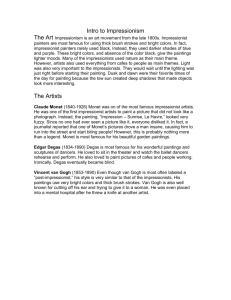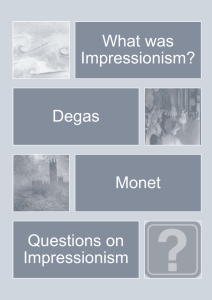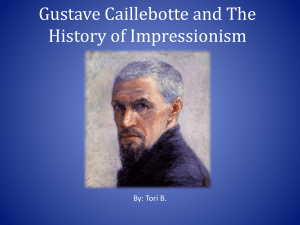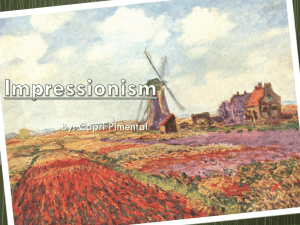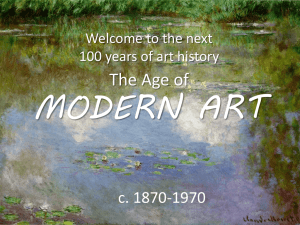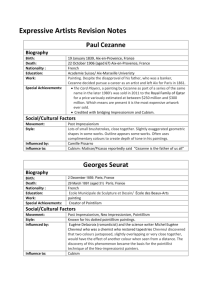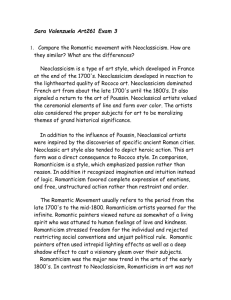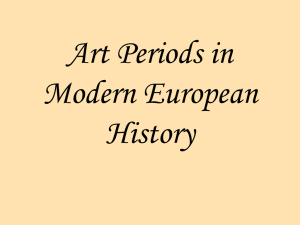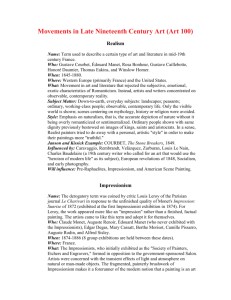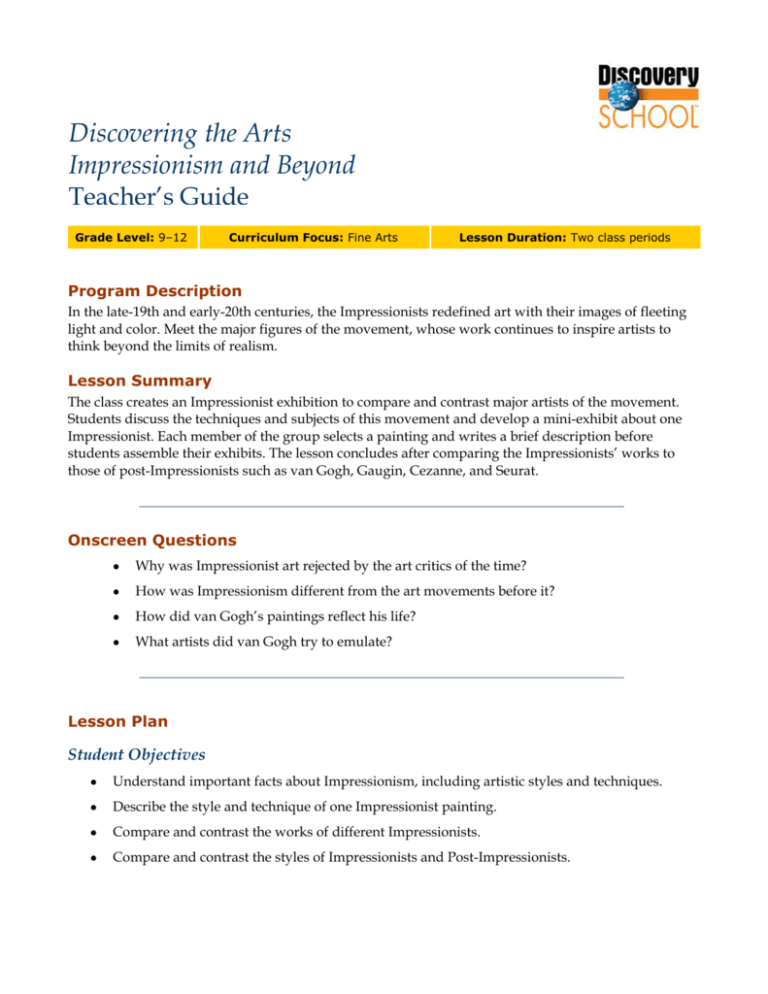
Discovering the Arts
Impressionism and Beyond
Teacher’s Guide
Grade Level: 9–12
Curriculum Focus: Fine Arts
Lesson Duration: Two class periods
Program Description
In the late-19th and early-20th centuries, the Impressionists redefined art with their images of fleeting
light and color. Meet the major figures of the movement, whose work continues to inspire artists to
think beyond the limits of realism.
Lesson Summary
The class creates an Impressionist exhibition to compare and contrast major artists of the movement.
Students discuss the techniques and subjects of this movement and develop a mini-exhibit about one
Impressionist. Each member of the group selects a painting and writes a brief description before
students assemble their exhibits. The lesson concludes after comparing the Impressionists’ works to
those of post-Impressionists such as van Gogh, Gaugin, Cezanne, and Seurat.
Onscreen Questions
•
Why was Impressionist art rejected by the art critics of the time?
•
How was Impressionism different from the art movements before it?
•
How did van Gogh’s paintings reflect his life?
•
What artists did van Gogh try to emulate?
Lesson Plan
Student Objectives
•
Understand important facts about Impressionism, including artistic styles and techniques.
•
Describe the style and technique of one Impressionist painting.
•
Compare and contrast the works of different Impressionists.
•
Compare and contrast the styles of Impressionists and Post-Impressionists.
Discovering the Arts
Impressionism and Beyond
Teacher’s Guide
Materials
•
Discovering the Arts: Impressionism and Beyond video
•
Computer with Internet access
•
Color printer
Procedures
1. After watching the video, remind students that Impressionism was an artistic movement that
begin in Paris in the 1860s. Ask students to think about the paintings featured in the video and
describe the typical style of these works. What did students notice about the palette and the
brushstrokes? How was light important to the Impressionists? Would students describe these
works as realistic? Why or why not?
2. Talk about the subject matter. Were the paintings typically illustrating aristocracy? What was
the typical setting of these paintings, inside or outdoors? How were these paintings like
photographs? How were they like still images within a movie?
3. Remind the class that although there were basic similarities among the Impressionists, there
were also important differences. Tell the class that they’re going to create a classroom
Impressionist exhibition to compare and contrast some of the major artists of the movement.
Divide the class into small groups and explain that each group is going to create a mini-exhibit
about one Impressionist. Assign or let each group choose one of the following artists:
•
Mary Cassatt
•
Edgar Degas
•
Edouard Manet
•
Claude Monet
•
Berthe Morisot
•
Camille Pissarro
•
Pierre-Auguste Renoir
•
Alfred Sisley
4. Have groups work together to explore the works of their assigned artist. Within each group,
have each student select and make a color printout of one painting considered a good
representation of Impressionism. Many works for each painter are at the following sites:
•
Impressionism
http://www.ibiblio.org/wm/paint/theme/impressionnisme.html
•
Impressionism
http://www.abcgallery.com/movemind.html#Impressionism
5. Have each student create a label for a selected work, including the artist name, title, date,
and a description, which should address the following:
Published by Discovery Education. © 2006. All rights reserved.
2
Discovering the Arts
Impressionism and Beyond
Teacher’s Guide
3
•
Describe the subject: What does the artist show in this picture? What details or symbols
give clues to its meaning? Where is the scene supposed to take place?
•
Describe the technique: How would you describe the artist’s use of color and light? How
would you describe the brushstroke?
•
Why would this be considered an Impressionist work?
•
How is it different from the work of other Impressionists? What makes this work unique
to this particular artist?
6. Have groups post their images and descriptions together in a designated spot around the room.
Give students an opportunity to walk around the classroom, viewing and reading about works
by other Impressionists. Then come together and have a class discussion comparing and
contrasting these artists. How are they alike? What makes each artist unique?
7. To conclude the lesson, show students works by the following artists: Vincent Van Gogh, Paul
Cezanne, Paul Gaugin, and Georges Seurat. Explain that these artists are often considered
Postimpressionists. The following site links to several works from these artists:
•
Postimpressionism (see also Georges Seurat under “Pointillism”)
http://www.abcgallery.com/movemind.html#Post-Impressionism
8. Ask students to examine these works and compare them to those in their Impressionist
exhibition. What similarities do they see? How might the Impressionists have inspired them?
How are they different? How did the artists break away from the Impressionists? (Many of
these artists continued to show real-life subject matter, using bright colors and visible
brushstrokes. And like the Impressionists, these artists were not interested in showing a realistic
view of the word with fine details. However, the Postimpressionists moved even farther away
from realism, often showing subjects in more abstract, geometric forms, sometimes in
unnaturally bright or unexpected colors.)
Assessment
Use the following three-point rubric to evaluate students’ work during this lesson.
•
3 points: Students demonstrated a strong understanding of Impressionism, including
artistic styles and techniques; developed a clear, thoughtful description of the subject matter
and technique of one Impressionist painting, answering all the questions; provided at least
one similarity and one difference among the Impressionists; provided at least one similarity
and one difference between Impressionists and Postimpressionists.
•
2 points: Students demonstrated a satisfactory understanding of Impressionism, including
artistic styles and techniques; developed a clear, complete description of the subject matter
and technique of one Impressionist painting, answering most of the questions; provided at
least one similarity or one difference among the Impressionists; provided at least one
similarity or one difference between Impressionists and Postimpressionists.
•
1 point: Students demonstrated a poor understanding of Impressionism, including artistic
styles and techniques; developed an incomplete or unclear description of the subject matter
Published by Discovery Education. © 2006. All rights reserved.
Discovering the Arts
Impressionism and Beyond
Teacher’s Guide
4
and technique of one Impressionist painting, answering few of the questions; had difficulty
identifying any similarities or differences among the Impressionists; had difficulty
identifying any similarities or differences between Impressionists and Postimpressionists.
Vocabulary
absinthe
Definition: An addictive, intoxicating drink made from wormwood; a cross between hard liquor
and heroin
Context: Degas’ most famous painting of café life is “Absinthe Drinker,” depicting a woman
stupefied by a narcotic drink sitting next to an alcoholic.
allegorical
Definition: Showing something with symbols that represent something about human life
Context: Adolphe Bouguereau quickly sold this 19th-century adaptation of Botticelli’s “Birth of
Venus.” The angels and cupids make the woman allegorical, or noble.
Impressionism
Definition: An artistic movement or style of painting in which brushstrokes of bright colors are
used to show the effects of reflected light
Context: Impressionism means painting nature in bright colors, such as painting the light that
falls on a pleasant object.
perspective
Definition: The appearance of objects in a painting or drawing that shows their distance from the
observer
Context: The architectural details and perspective had been minutely worked out before he
painted the scene.
Salon
Definition: An official art exhibition in Paris sanctioned by a government-approved jury;
beginning in the 18th century, the exhibition was public and held in the Louvre.
Context: For the artist who wanted to make a living in France in the 1860s, there was one gallery
where his paintings simply had to hang, the Salon in Paris.
Academic Standards
National Arts Education Associations
The National Arts Education Associations have developed national guidelines for what students
should know and be able to do in the arts. To view the standards online, go to artsedge.kennedycenter.org/teach/standards.cfm.
This lesson plan addresses the following national standards:
Published by Discovery Education. © 2006. All rights reserved.
Discovering the Arts
Impressionism and Beyond
Teacher’s Guide
•
Understanding and applying media, techniques, and processes
•
Using knowledge of structures and functions
•
Choosing and evaluating a range of subject matter, symbols, and ideas
•
Understanding the visual arts in relation to history and cultures
•
Reflecting upon and assessing the characteristics and merits of their work and the work
of others
5
DVD Content
This program is available in an interactive DVD format. The following information and activities are
specific to the DVD version.
How To Use the DVD
The DVD starting screen has the following options:
Play Video—This plays the video from start to finish. There are no programmed stops, except by
using a remote control. With a computer, depending on the particular software player, a pause
button is included with the other video controls.
Video Index—Here the video is divided into sections indicated by video thumbnail icons; brief
descriptions are noted for each one. Watching all parts in sequence is similar to watching the video
from start to finish. To play a particular segment, press Enter on the remote for TV playback; on a
computer, click once to highlight a thumbnail and read the accompanying text description and click
again to start the video.
Curriculum Units—These are specially edited video segments pulled from different sections of the
video (see below). These nonlinear segments align with key ideas in the unit of instruction. They
include onscreen pre- and post-viewing questions, reproduced below in this Teacher’s Guide. Total
running times for these segments are noted. To play a particular segment, press Enter on the TV
remote or click once on the Curriculum Unit title on a computer.
Standards Link—Selecting this option displays a single screen that lists the national academic
standards the video addresses.
Teacher Resources—This screen gives the technical support number and Web site address.
Video Index
I. The Rise of Impressionism (22 min.)
Rejected by critics, impressionist art was a radical new way of capturing moments in time. Examine the
major impressionist artists and their art.
Published by Discovery Education. © 2006. All rights reserved.
Discovering the Arts
Impressionism and Beyond
Teacher’s Guide
6
II. Becoming Van Gogh (27 min.)
Vincent Van Gogh broke the impressionist mold. Take a deeper look into the mind of this talented and
troubled artist.
Curriculum Units
1. Creating the Impressionist Movement
Pre-viewing question
Q: Have you ever liked something even though it did not fit with the prevailing trend or fashion?
A: Answers will vary.
Post-viewing question
Q: Was the first impressionist exhibition a success?
A: Yes and no. While the first impressionist gallery was a financial loss and a critical failure, it brought
together a group of artists who were painting in that style.
2. Morisot, Renoir, and Monet
Pre-viewing question
Q: How would you describe the impressionist style?
A: Answers will vary.
Post-viewing question
Q: How did Monet portray people in his paintings?
A: Monet was never interested in portraits. As a result, people in his paintings are depicted with
clumps of color. Although he studied classical painting, Monet was least interested in human anatomy.
No human stress or emotion ever appears in his paintings.
3. The Artistic Styles of Degas and Manet
Pre-viewing question
Q: What do you think life would be like without cameras and photographs?
A: Answers will vary.
Post-viewing question
Q: How did Degas approach his work?
A: Degas did not like spontaneity in art. He defined the architectural details and perspective of his
paintings before he began painting. He drew numerous sketches of his subjects before painting them
on canvas.
4. Degas’ Dancers and Manet’s Barmaid
Pre-viewing question
Q: What do you like or dislike about the impressionist style?
A: Answers will vary.
Post-viewing question
Q: Describe Edouard Manet’s final painting.
A: A Bar at the Folies-Bergère was Manet’s final painting. Painted a year before he died, it was his own
epitaph as well as an epitaph for impressionism. In the painting, a mirror reflects the friends that Manet
is leaving. The barmaid’s eyes appear to be looking at the viewer, but on the right, the mirror reflects
Published by Discovery Education. © 2006. All rights reserved.
Discovering the Arts
Impressionism and Beyond
Teacher’s Guide
7
her looking beyond the viewer. In front of the barmaid are pink and white roses. They symbolize the
idea of “purity forever.”
5. Becoming an Artist: Vincent Van Gogh’s Early Years
Pre-viewing question
Q: What do you know about Vincent Van Gogh?
A: Answers will vary.
Post-viewing question
Q: How did Van Gogh become an artist?
A: Van Gogh was expected to become a middle-class minister like his father. However, his view of
religion was fiercer and darker than that of his father. As a result, he was dismissed from divinity
school. Van Gogh gave up organized religion to pursue a career as a professional artist.
6. Van Gogh Experiments with Impressionism
Pre-viewing question
Q: Have you ever tried to copy or emulate someone’s style?
A: Answers will vary.
Post-viewing question
Q: Why was Van Gogh unsuccessful at painting in the impressionist style?
A: While living in Paris, Van Gogh attempted to become an impressionist. However, he was unable to
paint colors conventionally. He attempted to use delicate colors but could not mute the intensity with
which he painted the world around him. His impressionist landscapes were indistinguishable and
ordinary.
7. Van Gogh in the South of France
Pre-viewing question
Q: What are some things you have learned from your friends?
A: Answers will vary.
Post-viewing question
Q: Why did Van Gogh leave Paris?
A: Van Gogh left Paris to establish a studio in the south of France. He also left Paris because he was
addicted to absinthe. Van Gogh’s brother Theo encouraged him to move out and live on his own.
8. The Madness Returns: Van Gogh’s Final Works
Pre-viewing question
Q: How do you think depression and mental illness affect an artist’s work?
A: Answers will vary.
Post-viewing question
Q: Why is it ironic that Van Gogh is known as “the mad painter”?
A: It is ironic that Van Gogh is known as “the mad painter” because he did not produce works of merit
during his periods of depression and illness. He was only able to paint during periods of sanity.
Published by Discovery Education. © 2006. All rights reserved.

